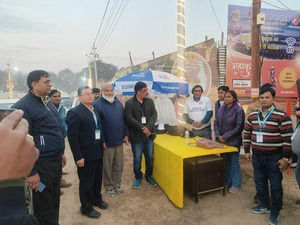Have you ever noticed white chalk marks on your car’s tires and wondered who put them there — or why? It’s natural to feel concerned when you see unfamiliar markings on your vehicle. While it might spark initial concern, the reason behind these markings is less alarming than you might think. Parking enforcement officers commonly make these chalk markings on your tires to monitor how long a vehicle remains parked in a time-limited zone.
Advertisement
This practice is called tire chalking, and it has been a routine method for decades. It offers parking meter personnel or parking enforcement officers a simple solution for tracking parking durations. The purpose of the chalk is to ensure vehicles comply with designated time limits in particular parking areas. Much like how certain car technologies face bans due to legal reasons, tire chalking has come under legal scrutiny in the United States in recent years, with courts questioning the validity and legality of the chalking method. In response, many municipal law enforcement agencies are introducing more advanced alternatives, such as License Plate Recognition (LPR) systems, to modernize parking enforcement.
Advertisement
What do the chalk marks on your tires mean?
Tire chalking is a traditional and manual approach to parking enforcement. The method involves marking a parked vehicle’s tires with chalk to monitor how long it remains in a time-limited zone. When the car is parked, a parking enforcement officer discreetly applies a white mark to one of its tires. The marking is typically in the form of a line from the tire to the pavement, which makes it easy to notice if the car has moved.
Advertisement
After an allotted time, typically around 15 minutes, the officer revisits the area. If the marked car is still parked, it means the vehicle has overstayed the permitted time. In this case, overstaying may warrant a parking violation notice. The tire chalking method has been widely used across the United States due to its low cost and ease of implementation.
However, the system has several drawbacks, one being that weather conditions such as rain or snow can wash away the marks, rendering the system ineffective. Also, since this is done discreetly, drivers aware of the practice can simply remove the chalk mark or reposition their vehicle to avoid detection. To top it off, chalking by parking enforcement officers can also feel intrusive to drivers and may raise questions about the method’s fairness.
Advertisement
Controversy surrounding tire chalking
While tire chalking has been in practice for a long time, it has sparked a lot of legal and constitutional debates in recent years. The primary issue lies in whether this method violates the Fourth Amendment of the U.S. Constitution, which protects citizens from unreasonable searches and seizures. Critics argue that tire chalking amounts to an unconstitutional invasion of privacy, as it allows government officials to track vehicles without consent. The practice has also faced accusations of discrimination, particularly against low-income communities that lack access to private parking. This makes them more susceptible to fines.
Advertisement
One of the most notable challenges to the tire chalking system emerged in 2019 when Alison Taylor, a Michigan resident, brought her case against the city of Saginaw to the U.S. Court of Appeals. Frustrated after receiving up to 15 parking citations, Taylor argued that marking a car’s tires was a form of trespass and an unreasonable search under the Fourth Amendment. The court ultimately ruled in her favor and declared tire chalking unconstitutional.
The court’s decision drew upon a U.S. Supreme Court precedent that classified attaching a GPS tracking device to a car as a “search.” Similarly, marking a tire with chalk — essentially tracking its presence — was deemed an invasive method requiring a warrant. The court also said tire chalking targets vehicles still in compliance with parking rules, likening it to initiating a search without probable cause. Despite the court ruling, tire chalking has not been outlawed entirely. The decision applies to states within the Sixth Circuit’s jurisdiction, including Michigan, Ohio, Kentucky, and Tennessee. In other states, tire chalking continues to be used as a low-cost enforcement method, albeit still under scrutiny.
Advertisement
Alternatives to tire chalking
As concerns over the legality of tire chalking grow, parking enforcement agencies are adopting modern and digital methods. One of the most notable alternatives is the Automatic License Plate Recognition (LPR) technology. Often referred to as digital tire chalking, LPR uses digital tools to track parked vehicles, making marking with physical chalk obsolete. Parking enforcement officers simply scan a vehicle’s license plate, which is then logged into a centralized database. If the vehicle exceeds its allowed parking time, the system flags it automatically and sends alerts to the officer to issue a ticket. Unlike traditional chalking, the LPR technology has a contactless approach.
Advertisement
Another alternative to tire chalking is virtual chalking. This system uses digital sensors or GPS technology to monitor how long a vehicle remains parked. Unlike physical chalk marks, virtual chalking is tamper-proof and is unaffected by factors such as rain or tire rotation. Enforcement officers can log and track vehicles using mobile or handheld devices. The platform offers data management features, which allow officers to sort and organize records by license plate, time, or location. As a car owner, knowing the precautions to take when parking your vehicle could save you from violations or unexpected digital chalking issues.











